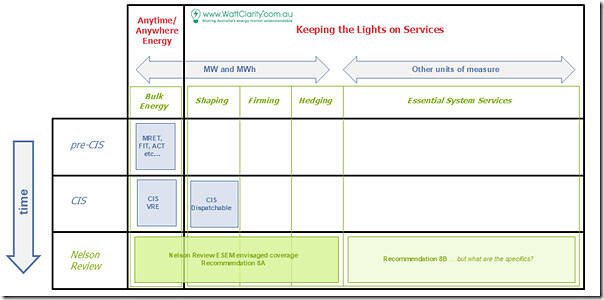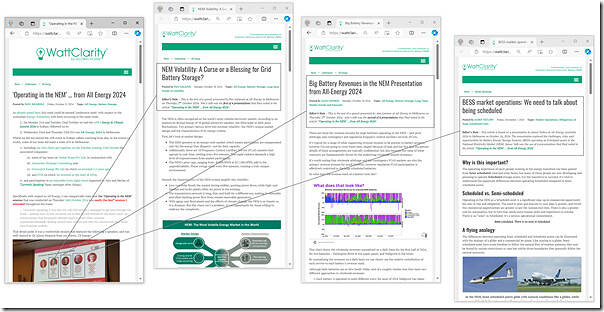As noted yesterday, we’re keeping in mind these ‘3 high-level questions, for considering the draft report of the Nelson Review’ … and we’re doing so now, at least in part, because in 8 days time I’ll be speaking at the second day of the inaugural NEMdev conference in Brisbane (i.e. on Wednesday 8th October 2025).
The Nelson Review panel identifies ‘the Schism’
One paragraph that jumped out to me was on p59 with the first paragraph starting with a sentence that reads to me like it says:
‘The Panel has recognised that ‘the schism’ has emerged … though various others identified that earlier’
Now, I’ll continue to explain what I mean – to help with which, it might be worth copying in the full text of that paragraph – which states (with my emphasis added):
‘The Panel has identified that most historic policy interventions have been incomplete. For example, the Renewable Energy Target required investments in new renewables to displace the bulk energy from existing emissions-intensive generation. However, a more comprehensive policy suite would have also addressed critical services that these emissions-intensive generators provided, which are now absent unless supplied by other entities.
These services include:
• Shaping: Matching the intraday and inter-day profiles of supply and demand to meet regular peaks
• Firming: Very long-duration and dispatchable resources that can be delivered as needed
• Essential system services: Services that maintain voltage, wave form and tolerance to faults
• Usable hedging contracts: Derivatives that allow market customers to manage risk and stabilise prices.’
What have we meant by ‘the Schism’ … when we have written about it before?
Back in 2018 when we* were working on compiling the mammoth Analytical + Statistical report that became the GRC2018, we compiled 14 Key Themes … with Theme 5 titled ‘The NEM has developed an ‘them and us’ schism’.
1) Given the increasing relevance of (and interest in) this schism, we subsequently decided to copy the full text of this Theme into the article ‘The NEM has developed a ‘them and us’ schism (GRC2018 Theme 5)’ here on Wattclarity.
2) This schism was then discussed elsewhere – such as:
(a) Briefly in this article of 8th August 2019 … and even as far back as August 2014
(b) And noted in Giles’ initial review of the GRC2018.
(c) The concept of ‘Anytime/Anywhere Energy’ was referenced in an explanation about negative prices through winter 2019 in this article “As power prices crash below zero, don’t expect it to show up on your power bill” from Stephen Letts at ABC News on Monday 9th September 2019.
3) This schism has emerged because of the form of support for Wind and Solar developments.
(Three years after the GRC2018) in compiling GenInsights21, we* settled on 22 Key Observations – within which Observation 2 (that ‘The Schism seems permanent’) also spoke back to the same concerns, and provided an update.
… similarly, given the ongoing interest in (and relevance of) these discussions, we subsequently decided to copy the full text of this Theme into the article ‘The schism seems permanent! (GenInsights21 Observation 2)’ here on Wattclarity.
In the ~4 years since the publication of GenInsights21, the discussions have continued…
* Who is “we”?
In the case of both the GRC2018 and GenInsights21, the ‘we’ represents both:
(a) is our team at Global-Roam Pty Ltd (producers of this WattClarity service)
(b) working in tandem with the team at Greenview Strategic Consulting (as at Sept 2025 now part of Azzo).
How do the Nelson Review (draft) recommendations fit with the Schism?
Coincident with my preparation for next week’s NEMDev conference, and this review of the draft Report from the Nelson Review, Dan Lee has now prepared and published 3 parts of a review of some considerations with respect to the Capacity Investment Scheme.
In the following diagram we tie all these threads together what we see as a progression in the coverage of the various major Government-promoted schemes for the development of capacity* to promote this energy transition:
* noting that ‘hedging’ does not represent physical capacity of a certain type, but included here because the Nelson Review draft Report speaks directly to the desire to provide additional capacity for hedging by the use of fungible provides in the ESEM.
The main intent of the diagram here is to highlight the following:
The Good… (acknowledgement and) coverage is expanding
Briefly walking down the table:
Step 1) pre CIS
In the pre-CIS world, we started with very narrow range of support for development of new capacity:
(a) The MRET, the various Feed in Tariff arrangements, and the State-based targets (firstly ACT and then VIC, etc) almost singularly spoke to the promotion of ‘Anytime/Anywhere Energy’ (which the Nelson Review terms as ‘Bulk Energy’).
(b) But with ‘Keeping the Lights on Services’ completely ignored (and not even really acknowledged) … which is what prompted us to write about the schism in the first place.
That’s my read of what the Nelson Review panel means when it writes ‘The Panel has identified that most historic policy interventions have been incomplete.’
Step 2) with the CIS
With respect to the Capacity Investment Scheme there was a small improvement:
(a) In the early days of the CIS, there was some some promise that it might help in the delivery of some dispatchable capacity:
i. Remember that it was on 14th May 2023 that I wrote ‘We’re not building enough replacement dispatchable capacity’.
ii. This was after the announcement of the CIS (Dec 2022) but before the discussion paper released (Aug 2023).
iii. At which time I had been hoping that a rational design would have covered both of what the Nelson Review describes as ‘shaping’ and ‘firming’
(b) But then …
i. Alas, politics became involved, and any effort to include gas-fired generation was excluded; and
ii. Furthermore, because of the nature of the services elicited in Tender 1 (see Dan’s detailed gantt chart here), these services were much more focused on what the Nelson Review describes as ‘shaping’ and almost not at all on ‘firming’.
iii. What compounded the disappointment was that ‘the big expansion’ of November 2023 was announced – representing almost a sidelining of attention from ‘Keeping the Lights on Services’ and imparting yet more focus on ‘Anytime/Anywhere Energy’.
(c) And then more recently in Part 1 of his series, Dan Lee’s been asking the question ‘how firm are these CIS projects in any case?’ … which is important to know, in order to assess which of these 6 different lenses is actually most useful to use to understand the reliability projections in the 2025 ESOO.
So, in my view, not a glowing success…
Step 3) post Nelson Review
Which brings us to the Nelson Review’s ideas about the establishment of an Electricity Service Entry Mechanism (ESEM) – which should get some credit for giving some consideration of the need for ‘Keeping the Lights on Services’:
(a) The idea of trying to structure these means of support as ‘fungible, financial contracts for the later years’ is certainly intriguing
(b) at this point I’ve not had sufficient time to really understand the details of how such things would work … but am interested to learn more.
But there may still be gaps (re Capacity)?
I note that Recommendation 8B is as follows:
‘8B: Where cost-effective, projects facilitated through the ESEM should also be able to provide essential system services (ESS)
The ESEM administrator should coordinate with TNSPs. This should take the form of secondary contracting for the specific elements of the project that relate to providing ESS.’
… but am unclear of the specifics in terms of how this might work?
But wait, there’s more … it’s not just about Capacity!
Before we finish off today, it’s worth highlighting that other reason why we coined the term ‘the Schism’ to describe what we saw emerging those years ago.
- It was not just about the development of Capacity (i.e. technology on the ground)
- It was also about the development of Organisational Capability
- i.e. in the new organisations emerging to assist in the energy transition
- but also with respect to associated stakeholders, including:
- those who serve those generators; but also
- more generally, those others that operate in the ecosystem (including media organisations).
Our sense has been that the way in which ‘Anytime/Anywhere Energy’ has been incentivised as actively worked against the development of more rounded/mature Organisational Capability:
- That has often cost these new organisations money, at the end of the day;
- And it may well have contributed to delays in the closure of coal.
At last year’s All Energy forum, James Tetlow of Overwatch Energy used the analogy of ‘flying a glider’ vs ‘flying a plane’
- to explain the difference in Organisational Capability required
- this was done during his talk (and subsequent article) ‘BESS market operations: We need to talk about being scheduled’ as part of a series of valuable presentations in the ‘Operating in the NEM’ session:
We’ve wondered about capability development before – for instance:
- Back on 9th March 2020 we wondered whether ‘We’ve been killing New Entrants with kindness?’ because of the forms of support provided to VRE up to that point.
- On several occasions (such as in GenInsights21) we’ve wondered … is the Semi-Scheduled category Sustainable or Scalable? (in part because of capability development questions).
So my thoughts, in reviewing what’s envisaged (e.g. with the ESEM) in the draft Report of the Nelson Review:
- Is not just about the Capacity on the ground;
- It’s also about the Organisational Capability we’re incentivising the development of.
… does what’s proposed in the Nelson Review also assist with the development of Organisational (and broader Industry) Capability?




Be the first to comment on "The Nelson Review panel ‘has identified’ the Schism"